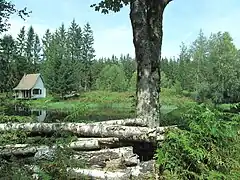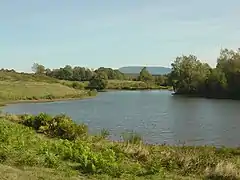


The Plateau des Mille étangs (literally : "Thousand Ponds Plateau") is a geographical area of more than 220 km2 located in the northeast part of the Haute-Saône department in the french region of Bourgogne-Franche-Comté.[1]
At the end of the Last Glacial Period, 12,000 years ago, the retreat of the Moselle glacier overflowing above the Vosges formed deepening in the primary basement which covered the region favoring the formation of peatlands, swamps in three plateaus of different altitudes. In the Middle Ages, the space was transformed by Man, who developed fish farming there by developing ponds. These water reserves were then used in the 19th and 20th centuries by the local textile and paper industries.[2]
At the beginning of the 21st century, this region, mostly covered with forest, is of environmental interest due to its wetlands which are home to remarkable biotopes adapted to a cold and humid environment. This Thousand Ponds region is recognized as a Zone naturelle d'intérêt écologique, faunistique et floristique (ZNIEFF), it is largely included in a Natura 2000[3] area and in the Ballons des Vosges Nature Park; to the south is the Grande Pile peat bog regional nature reserve. The Thousand Ponds also have a tourist interest by its landscapes which are worth to him the nickname of "Little Finland" by analogy with the "Thousand Lakes" Finnish.
- Landscape
 Forest
Forest Meadow with ballon de Servance in the background
Meadow with ballon de Servance in the background Typical pond with fisherman's hut
Typical pond with fisherman's hut Grands Prés ponds at La Voivre
Grands Prés ponds at La Voivre
References
- ↑ (in French) Natacha Ferrer, Plateau des mille étangs - FR4301346 - document d'objectif, Parc naturel régional des Ballons des Vosges, 2008, 109 p.
- ↑ (in French) Denis Mathis, « Les enjeux des paysages d’eau dans la construction du Pays des Mille Étangs », Revue Géographique de l'Est, vol.56 / n°1-2, 2016, p. 1-18.
- ↑ (in French) Le plateau des Mille Étangs, Natura 2000, Inventaire national du patrimoine naturel (INPN)